
Decline and Fall of the Roman Empire, originally titled Decline and Fall: The Game of the Barbarian Invasions, is a board game published by Wargames Research Group (WRG) in 1972 in which 4th-century Rome struggles against invading barbarians.

Decline and Fall of the Roman Empire, originally titled Decline and Fall: The Game of the Barbarian Invasions, is a board game published by Wargames Research Group (WRG) in 1972 in which 4th-century Rome struggles against invading barbarians.
Decline and Fall of the Roman Empire is a 4-player game in which one player takes the role of Rome and tries to maintain control of its lands, while the other three players control the Huns, the Goths and the Vandals. [1] The mounted hex grid map shows the Roman Empire in 375 AD, which is when the game starts.
Each player, on their turn, moves, engages in combat and moves again. A full game turn, when all four players have completed a turn, represents five years in game time. The game ends after fifteen turns. [2] The more territory the Goths and Vandals occupy, the more fighters they recruit to their cause. The Huns gather more recruits via destruction of cities and other units. [1] Once per game, each player can make an "Appeal to the Gods", roll a die and consult a chart to see the result. Although some of the results are miraculous, others are devastating. As critic William Davies commented, "Used by desperate players in a bad situation." [3]
The player with the most victory points at the end of the game wins. The Roman player accumulates victory points for saving their cities from destruction or invasion. The Goths and Vandals get victory points for looting Roman cities, and for the number of hexes they settle on by the end of the game. The Huns gather points for destroying other units (including Goths and Vandals) and for looting cities. The player with the most victory points at the end of the game is the winner. [2]
The game was created by Canadian game designer Terrence Peter Donnelly (who also created Mystic Wood and Sorcerer's Cave ). After a period of playtesting, Donnelly produced a test edition in 1972, and sent it to several game companies. [4] UK company WRG thought the game had potential, and published it in 1972 with the title Decline and Fall: The Game of the Barbarian Invasions. [4] It was republished by Ariel Productions in 1977 retitled Decline and Fall of the Roman Empire.
In Issue 14 of the UK magazine Games & Puzzles , William Davies found it to be "an absorbing and well-researched board game." He concluded, "this is a well produced game of infinite variety, allowing both skill in strategy and the full exercise of diplomatic ingenuity and double dealing — a game which can be both challenging and hilarious." [3] Several issues later, Bob O'Brien did an in-depth analysis of the game, and concluded "This is a game that can be played at many levels and can be enjoyed by all ages — it combines manoeuvre, diplomatic skill, role-playing, some insight into the history of the time — and great fun as well." [4]
In a 1976 poll carried out by Simulations Publications Inc. to determine the most popular board wargames in North America, Decline and Fall placed a disappointing 137th out of 202 games. [1]
In the 1977 book The Comprehensive Guide to Board Wargaming , Nicholas Palmer states that "this is disliked by experts because of its elementary rules and unbalanced structure, but it is a highly entertaining game for four players, if it's not taken too seriously." [1]
In The Guide to Simulations/Games for Education and Training, Martin Campion discussed using this game as an educational aid, saying, "I have used this game in several classes and it has always proved fascinating and suggestive. I have used it with individuals or with teams representing the various sides. The game gives a good idea of the chaos of the period represented." [2]
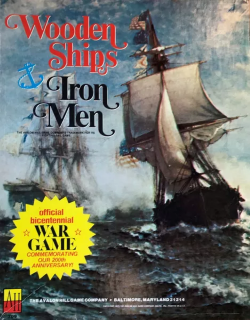
Wooden Ships and Iron Men is a naval board wargame simulating naval combat during the Age of Sail that was published by Battleline Publications in 1974, then revised and republished by Avalon Hill the following year.
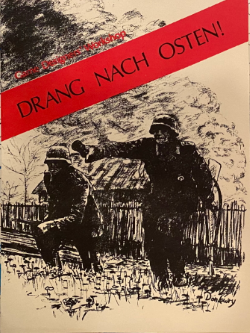
Drang Nach Osten! is a monster board wargame published in 1973 by Game Designers' Workshop (GDW) that simulates Operation Barbarossa, the German invasion of the Soviet Union in 1941. The game was the first of what was envisioned as a series of games with identical wargame rules and map scale that would simulate the entire Second World War in Europe.

1776, subtitled "The Game of the American Revolutionary War", is a board wargame published by Avalon Hill in 1974 that simulates the American Revolutionary War. Its release was timed to coincide with the bicentenary of the Revolution, and for several years was a bestseller for Avalon Hill.

Battle of the Bulge is a board wargame published by Avalon Hill (AH) in 1965 that simulates the World War II battle of the same name. General Anthony McAuliffe (ret.), who had been commanding officer at Bastogne during the Battle of the Bulge, was a consultant during the game's development. The game proved popular and sold over 120,000 copies, but was dogged by criticisms of historical inaccuracies, and was finally replaced by a completely new edition in 1981. A third edition in 1991 was released as part of the Smithsonian American History Series.
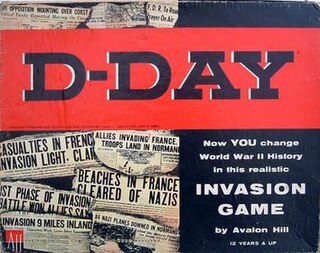
D-Day is a board wargame published by Avalon Hill in 1961 that simulates the six months of the European Campaign of World War II from the Normandy Invasion to the crossing of the Rhine. It was the first wargame to feature the now ubiquitous hex grid map and cardboard counters, and was revised and re-released in 1962, 1965, 1971, 1977 and 1991.

Alexander the Great is a board wargame first published by Guidon Games in 1971 that simulates the Battle of Arbela in 331 BCE, also known as the Battle of Gaugamela. A revised edition was published by Avalon Hill in 1974. Both editions of the game were notable for having what one critic described as "one of the ugliest maps ever to curse a war game."

Tactics is a board wargame published in 1954 by Avalon Hill as the company's first product. Although primitive by modern standards, it and its sequel, Tactics II, signalled the birth of modern board wargaming for the commercial market. Tactics is generally credited as being the first commercially successful board wargame.
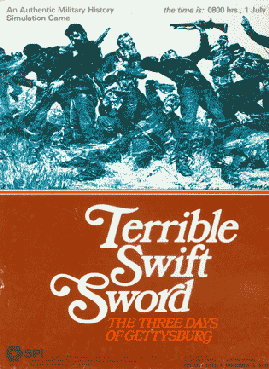
Terrible Swift Sword: Battle of Gettysburg Game is a grand tactical regimental level board wargame published by Simulations Publications, Inc. (SPI) in 1976 that simulates the Battle of Gettysburg during the American Civil War. A second edition was published by TSR in 1986.

Conquistador, originally subtitled "The Age of Exploration: 1495–1600", is a board game published by Simulations Publications, Inc. (SPI) in 1976 that simulates the exploration of the New World in the 16th century. Players take on the role of European countries sending expeditions to find gold and establish colonies. Although the design uses the trappings of board wargames such as a hex map, combat is not a major part of the game.
The siege of Florence was a battle that occurred in either 405 or 406 AD, between the Goths and the Roman Empire at Florence.

NATO: Operational Combat in Europe in the 1970s is a board wargame published by Simulations Publications Inc. (SPI) in 1973 that simulates an invasion of Western Europe by the Warsaw Pact.
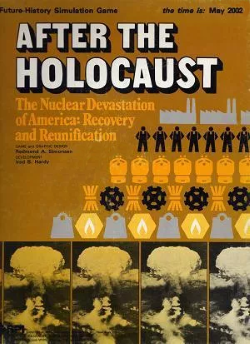
After the Holocaust, subtitled "The Nuclear Devastation of America: Recovery and Reunification", is a near-future board wargame published by Simulations Publications, Inc. (SPI) in 1976 that simulates the economic recovery of the United States following a nuclear war. The game was the third and last in SPI's "Power Politics" series.

The Barbarians, subtitled "Games of the Fall of Rome and the Mongol Invasion of Europe", is a set of two board wargames published by Yaquinto Publications in 1981.
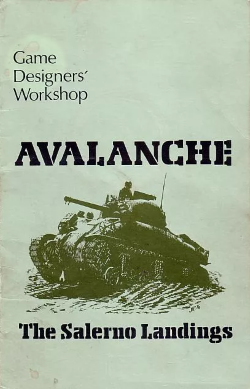
Avalanche: The Salerno Landings is a board wargame published by Game Designers' Workshop (GDW) in 1976 that simulates the nine-day battle for the beachhead at Salerno in September 1943 following the Allied amphibious landing known as Operation Avalanche.
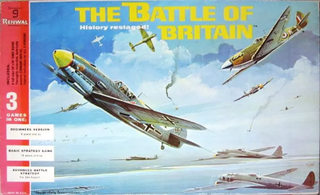
The Battle of Britain is a board wargame published by Gamescience in 1968 that is a simulation of the Battle of Britain during World War II.

The Battle of Borodino: Napoleon in Russia 1812 is a board wargame published by Simulations Publications Inc. (SPI) in 1972 that is a simulation of the Battle of Borodino during the French invasion of Russia in 1812.

The Conquerors is a package of two board wargames published by Simulations Publications Inc. (SPI) in 1977. One game, The Macedonians, simulates the invasion of Persia by Alexander the Great, and the other, The Romans, covers the eastward expansion of the Roman Empire following the Second Punic War.
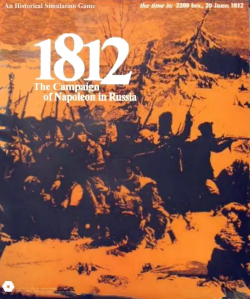
1812: The Campaign of Napoleon in Russia is a collection of two board wargames published by Simulations Publications Inc. (SPI) in 1972 that both simulate Napoleon's disastrous invasion of Russia. One game uses a traditional hex grid map, and the other uses a map of areas and regions.

Korea: The Mobile War is a board wargame published by Simulations Publications Inc. (SPI) in 1969 that simulates the Korean War.

East Front is a board wargame published by The Control Box, Inc. in 1976 that simulates combat on the Russo-German Front during World War II. The game had unusual hexagonal-shaped counters rather than the more traditional square counters.